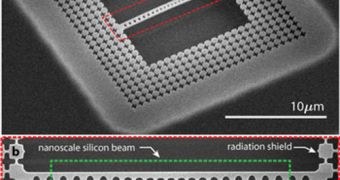In a new groundbreaking investigation, an international team of scientists was able to use special laser light to cool down a mechanical object to its lowest possible energy state. This is the first time such a feat is achieved using lasers.
Experts from the California Institute of Technology (Caltech), in Pasadena, worked closely with Austrian colleagues from the University of Vienna to develop this innovative cooling system, which may be used to conduct quantum experiments in the near future.
Additionally, the data accumulated from this study could be used in the development of next-generation sensors, devices that would be significantly more sensitive than anything on the market today. Details of the new study appear in the October 6 issue of the top scientific journal Nature.
For the research, experts constructed a tiny mechanical silicon beam at the nanoscale, made up of billions of atoms. Then they made this mechanical system permeable to a certain frequency of laser light, which was able to remove heat as it was reflected from inside the silicon beam.
As this happened, the system naturally cooled down. After fine-tuning their experimental setup, the joint team was able to cool down the beam until it reached its lowest-possible energy state. This is also called an object's quantum ground state.
“We've taken a solid mechanical system – one made up of billions of atoms – and used optical light to put it into a state in which it behaves according to the laws of quantum mechanics,” explains the principal investigator on the new study, Oskar Painter.
“In the past, this has only been achieved with trapped single atoms or ions,” adds the expert, who holds an appointment as a professor of applied physics and executive officer for applied physics and materials science at Caltech.
In this exotic state, objects experience the absolute minimum of mechanical vibrations they can produce. Sensors based on this technology could be used to detect the smallest forces or masses acting in their surroundings.
“In many ways, the experiment we've done provides a starting point for the really interesting quantum-mechanical experiments one wants to do,” Painter explains, saying that noisy thermal vibrations within normal sensors tend to mask the presence of small forces and masses.
The team now plans to extend its investigations, tailoring the new setup for increasingly complex applications. The work was sponsored by the Caltech Kavli Nanoscience Institute and the US Defense Advanced Research Projects Agency's (DARPA) Microsystems Technology Office.
Additional funds were secured from the US Air Force Office of Scientific Research, the European Commission, the European Research Council and the Austrian Science Fund.

 14 DAY TRIAL //
14 DAY TRIAL //